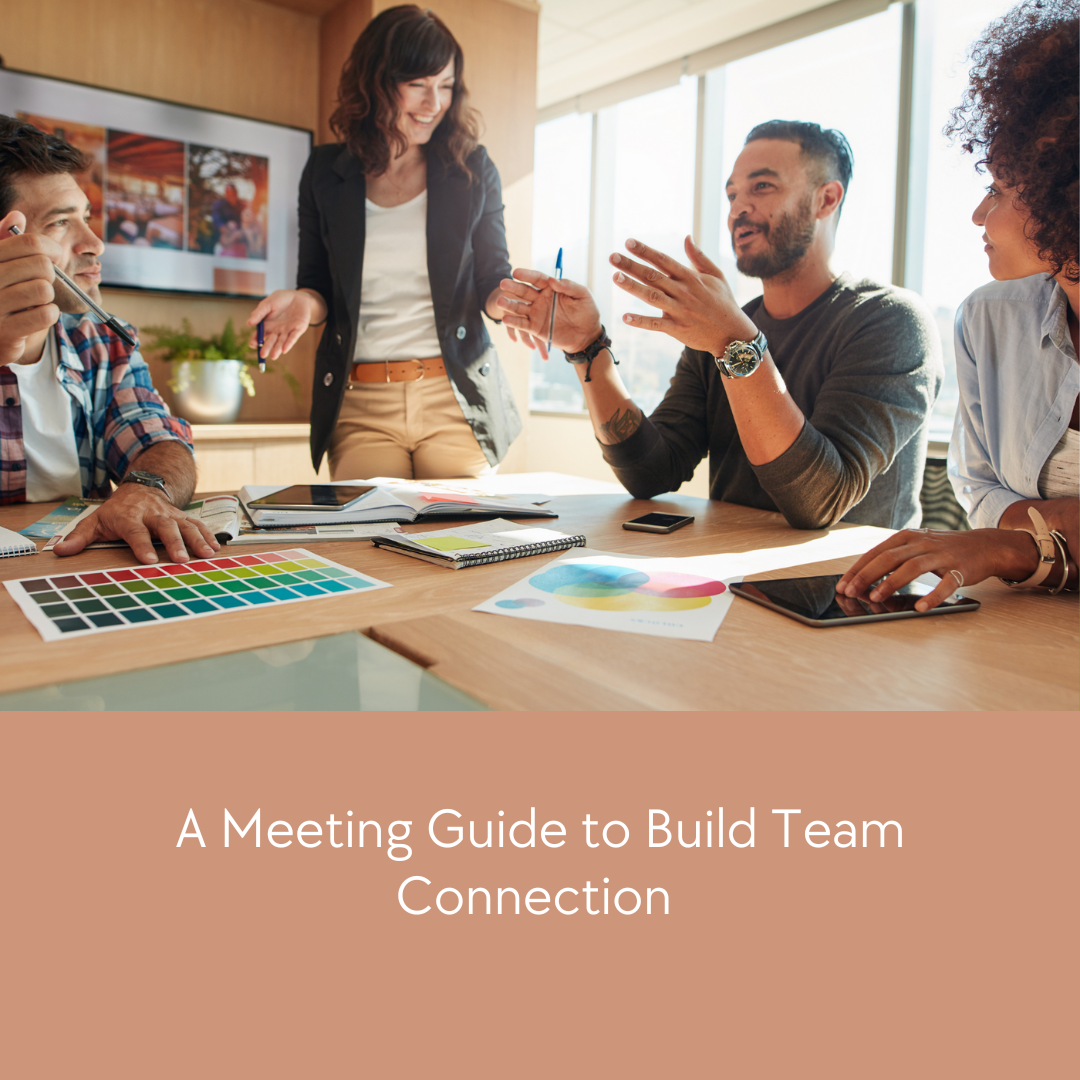How does it feel to be back at work?
For some of us, it’s been a few months since we’ve gone back to work in physical locations.
For others, we’re starting new roles.
For many the felt experience at work is mixed. What we value and consider important as leaders, staff and employees has changed.
For most of us, we need to adjust to coming back to work and working with new or changed teams.
So how do we do that?
A Meeting Guide To Build Connection with Your Team
As many people end a calendar year and start a new one, there are opportunities to build connection and belonging with teams.
Here’s one option: A meeting format to apply for your next team meeting or team retreat.
1. Name the Outcome
Share why you’re holding the meeting which is to help build or re-build connection with your team.
Share what you want as a result or outcome of the meeting: To build a shared understanding and awareness of where you are all starting from, what you collectively wish to achieve moving forward and how to make it happen!
2.Acknowledge
Next, acknowledge the times.
Share that you don’t take for granted that everyone is starting fresh and enthusiastic. In fact, given anxieties related to our Covid reality and the difficult truths that have been in the spotlight since the murder of George Floyd, the discovery of unmarked graves of Indigenous children on the grounds of former residential schools in Canada and much more, people will show-up to work in various states.
Name it and bring it to the forefront.
It will give your team permission to acknowledge (even if it’s only to themselves) their feelings because you are normalizing the current circumstances instead of aiming to work at a pace that doesn’t acknowledge the turbulence in our private and work lives over the past few years.
3.Check-in
Check-in with your staff. This isn’t just a quick, “How are you doing?/Fine” conversation. It’s a real ask.
Whether you’ve been in a leadership role for a while or are brand new to the role ask 1 or all the following questions:
- A few months back into work, how are you doing?
- What’s something you notice that is really good about being back at work? How can we build on this as a team? How can I support the continuation of what’s going well at work?
- What is something you notice that’s missing at work to make it feel safe, fun and energized? What can we do as a team to close the gaps? What can I do to close these gaps?
Use these questions to learn what would help them thrive at work and be open to taking actions or advocating for actions to be taken to make it happen.
Clearly, share what you’ve taken away, what can be immediately acted on and what you will circle back to them on with a deadline named.
Doing this manages expectations of your staff rather than setting-up expectations of possibilities only to have them dashed because there are challenges on following through.
4.Co-Create A New Shared Vision
While your organization’s vision and mission may not have changed, how you and your team intend to make it a reality likely has. This is a result of your experiences over the last 2 and half + years.
Take the time to sit down with your team to learn what does the vision and mission of the organization mean for them now and what does fulfilling the overarching objective for the team mean for them now?
How do they specifically expect and want to make the vision and mission a reality, given experiences:
- working remotely
- dealing with a changed composition of the team/organization due to high turn-over
- coming to grips with the global reckoning that how we work needs to change to be diverse, equitable and inclusive.
Ask them: What actions do they expect or want to be taken and what behaviours do they want to see?
Approach this as a group exercise, with curiosity. Encourage everyone to ditch the judgment and cynicism.
5.Build Shared Accountability
Now that there is a clear picture of what behaviours and actions are expected to fulfill the vision and mission of the organization and team, create a list of shared agreements of what behaviours and actions will realize the vision and mission.
This can be a tricky exercise to manage because of our inherent biases – especially if what is being suggested is so completely out of the normal (patriarchal, colonized, racialized) way of doing things.
When you feel resistance to ideas or others name their resistance to ideas, ask and answer this question:
What do we stand to lose and what will we gain if we do not agree to implement the proposed behaviour or action?
Let the clarity that comes from answering this question, inform your next action on whether to follow-through with the proposals.
6.Commit to Periodic, Consistent, Intentional Reflection and Learning
As you take actions based on these discussions, book intentional time to see how everything is going periodically and consistently (e.g. a monthly meeting only dedicated to this topic). This means you and the team reflecting on what is going well, what needs adjustments and what you couldn’t have anticipated but now know and that needs action. Accordingly take the next best steps for your team.
There you have it! A format to build team connection.
If you want more support for your team, as a whole, book an info meeting to learn about my trainings on Mindful Communication and How to Give and Receive Feedback.
Need a facilitator to support group discussions on EDI, negotiating back-to-work SOPs, or to help build a staff retreat to create belonging, book time for us to discuss your specific needs.
A nod of respect from me to you.
You are taking the time and investing your energy in something worthwhile:
To be empowered to make a difference.

P.S. Sometimes what is needed is the inner resilience and capacity to handle the varying needs of the people who report to you while managing expectations of your boss. If you need immediate support to help you lead with clarity, resilience and confidence, learn more here.
P.P.S. If an e-mail message is preferred, send it to jo@jorodrigues.net. Don’t forget to add my e-mail to your Contacts to avoid my response from going to your Spam folder.


5 comments
Comments are closed.